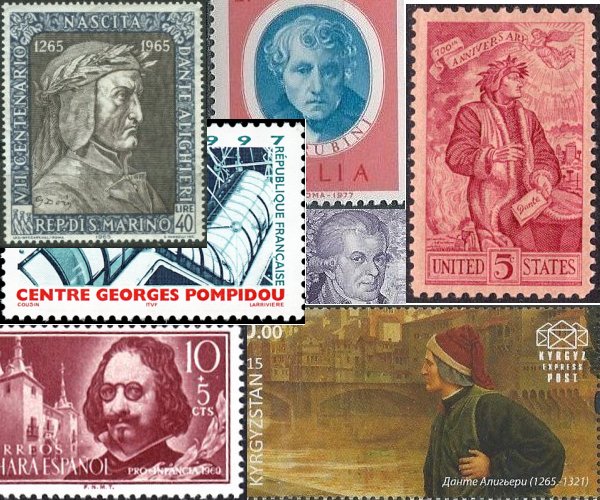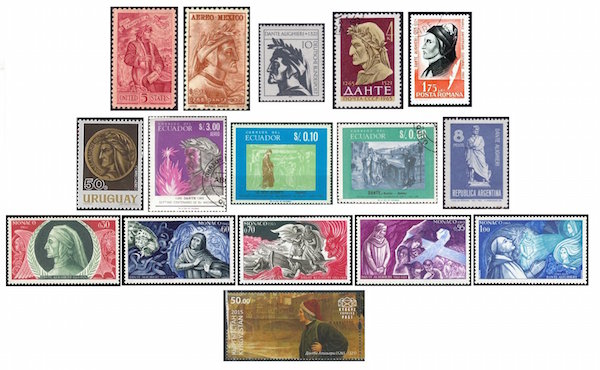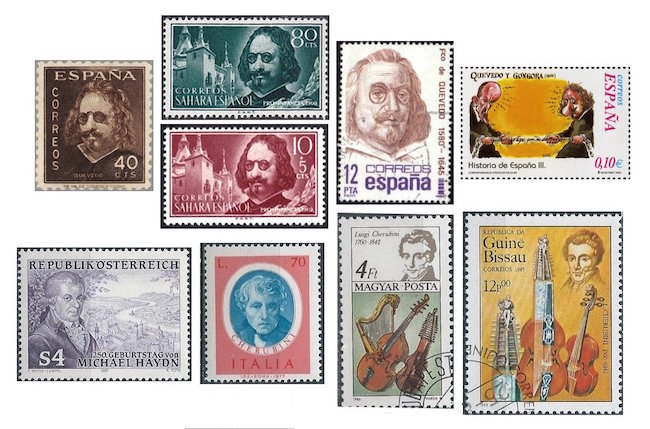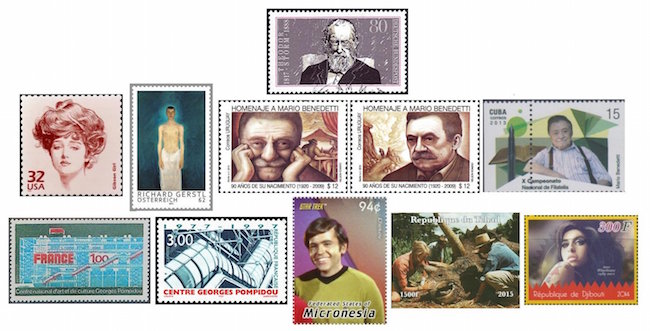The Arts on Stamps of the World — September 14
An Arts Fuse regular feature: the arts on stamps of the world.

By Doug Briscoe

King of the hill today is undoubtedly Dante Alighieri. He has as many stamps as some of the most prominent painters, and among writers I think only Goethe and Shakespeare are philatelically-quantitatively comparable. Durante degli Alighieri was born around 1265 and died on the night of 13/14 September, 1321. (French and German Wikipedia specifically cite the 14th, and I’m going with that because yesterday’s Arts on Stamps of the World was already top-heavy.) Now a shameful personal confession: I didn’t even start reading The Divine Comedy until 2013, and I’m still at it. Initially, I read it line by line with the original, but my Italian was not up to the task, and I abandoned that noble project after a fashion. Now midway through the Purgatorio, I occasionally pick up the book and consume another Canto, but essentially I believe that reading poetry in translation is at best unsatisfactory and at worst pointless. Recently I began reading A.N. Wilson’s Dante in Love, which helps.
As for the stamps, most of them, as you’d expect, come from Italy (including an interesting “pneumatic post” issue from 1945), with others predictably coming from San Marino and the Vatican, but I’d like to draw your attention to a couple of the other stamps, and for that we must proceed to Collage No. 2. As I’ve said here previously, the United States Postal Service is and has usually been very reluctant to honor non-Americans on stamps. American exceptionalism at its most typical. One of the exceptions, along with Shakespeare, Copernicus, Luther, Gutenberg, and some others (not Goethe), is Dante, who was remembered in 1965, on the occasion of the 700th anniversary of his birth. Other countries noted that anniversary, too, of course: Mexico, Germany, the USSR, Romania, and from South America, Uruguay, Ecuador, Argentina… I think the US and Mexican issues are among the most attractive designs, actually, but the five-stamp set from Monaco may deserve the blue ribbon. I recently acquired a beautiful stamp from, of all places, Kyrgyzstan, issued for the 750th anniversary, which other nations seem to have overlooked.

We travel a bit West and three centuries forward to salute the great Spanish poet Francisco de Quevedo (14 September 1580 – 8 September 1645). Born into a noble Castilian family, Quevedo was the son of a royal secretary and a lady-in-waiting to the queen, but both parents were dead by the time he was six. This sad fact certainly did not impede his education, and by the time he was 21 Quevedo, fluent in Greek, Latin, Arabic, Hebrew, French, and Italian, was already beginning to make a name for himself as a poet and writer of prose. Some of the poems appeared in a 1605 anthology. Now, Quevedo was a decidedly argumentative gentleman. Although he became friends with both Cervantes (whose birthday approaches) and Lope de Vega, Quevedo entered into vicious rivalries with Luis de Góngora and Juan Ruiz de Alarcón. Góngora in particular was Quevedo’s bête noire, and vice-versa. They tussled over the poetic styles of conceptismo (Quevedo) and culteranismo (Góngora). (I refer you to the Góngora article or to Wikipedia for clarification.) Although he himself was club-footed and myopic, he mocked Góngora’s hunchback and red hair. (Quevedo’s ever-present eyeglasses caused the word quevedos, meaning “pince-nez”, to enter the Spanish language.) Góngora gave as good as he got, and Quevedo’s life was not without its reverses: he was briefly exiled in 1620 and arrested (for what I don’t know, though likely it had something to do with his written denunciations of the Inquisition) in 1639. He smoked heavily and kept low company, but managed to produce a vast body of poetry and a novel, El Buscón (The Swindler or The Scavenger, 1626). There are also fifteen volumes of theology. All the stamps are from Spain or its colony Spanish Sahara (1960), with the most recent being a comic recreation of the storied literary contretemps.
Michael Haydn (1737 – 10 August 1806) was the younger brother of Franz Joseph Haydn and, like his elder sibling, a friend of Mozart. Lovers of Mozart’s music may wonder why we never hear his Symphony #37 (the “last ten symphonies” are nos. 31 to 41 inclusive, and there is always a gap between #36, the “Linz”, and #38, the “Prague”); this is because the elusive “#37” in G was actually composed by Michael Haydn. Mozart did compose the slow introduction to the first movement, and for this reason earlier musicologists attributed the entire symphony to his pen. The symphony has been recorded, with and without the Mozart intro, quite a few times. Another Mozart connection, and a wonderful anecdote, is that when Michael Haydn fell ill and was unable to complete a commission for a set of six duos for violin and viola, Mozart stepped in and composed the last two, allowing Michael to pass them off as his own. But how anybody with a lick of musical knowledge could fail to tell Mozart’s pieces from Michael Haydn’s is beyond me. The piquancy of this story is that the duos had been requested by Mozart’s former employer the odious Archbishop Colloredo, and Wolfgang must have taken secret delight in thinking he was putting one over on his old nemesis.

Another composer, Luigi Cherubini (1760 – 15 March 1842), is best known as the director of the Paris Conservatoire (from 1822) and composer of operas and large-scale sacred works, but he also composed six splendid string quartets that have largely been overlooked. It’s my belief that they deserve a place in the standard repertoire. Cherubini was held in high esteem by Beethoven but despised by Berlioz. Most sources (Grove Online and Wikipages in fifteen languages) agree that Cherubini was born on the 14th, with the demurrers being English and Polish Wikipedia, which both give September 8. I give you English-language Wikipedia’s rationale: “Although 14 September is sometimes stated, evidence from baptismal records and Cherubini himself suggests the 8th is correct. Perhaps the strongest evidence is his first name, Maria, which is traditional for a child born on 8 September, feast-day of the Nativity of the Virgin.” The similarity in design of the stamps from Hungary and Guinea-Bissau extends to the complete sets issued by both countries in 1985. (Both sets include stamps for Bach, Handel, and Chopin, but the other composers vary.)
Today is the bicentenary of the German poet Theodor Storm (14 September 1817 – 4 July 1888), whose best known works are two novellas written at the beginning and end of his career. He published his first volume of poems while studying law in Kiel. He went on to practice law and eventually became a magistrate. Storm is considered an important representative of realism in German literature. He met and corresponded for years with Turgenev.
Today is also the sesquicentennial of the American Charles Dana Gibson (September 14, 1867 – December 23, 1944), the man who created the Gibson Girl. (It is said that the cocktail may have been named for him, too.) Born in Roxbury, Massachusetts, Gibson sold his first drawing to Life magazine in 1886 and went on to contribute to that and other prominent New York periodicals (Harper’s, Scribners, Collier’s) for thirty years. In 1918 he became Life’s editor and later its owner. Among his book illustrations are the ones he did for the 1898 editions of Anthony Hope’s The Prisoner of Zenda. In was in that same year that Gibson introduced his characteristic female icon. Using his wife and her four sisters as a composite model, he established the Gibson Girl as a sophisticated, elegant representation of the modern American woman. Later, when the popularity of the Gibson Girl waned, the artist turned to working in oils. The Gibson Girl is resurrected on a retrospective sheet looking back to the first decade of the 20th century.
And we have next another painter in the Austrian Richard Gerstl (14 September 1883 – 4 November 1908). An indifferent student, Gerstl was gifted enough to be admitted to the Academy of Fine Arts Vienna when he was fifteen. He was a bit of loner and didn’t much associate with other artists, but he did make friends with musicians, Arnold Schoenberg and Alexander von Zemlinsky among them. I didn’t mention in my Schoenberg piece yesterday that the composer was also active as a painter, even exhibiting alongside Kandinsky and Franz Marc. Well, it seems Gerstl gave some art instruction to Schoenberg in these early days. He also painted Schoenberg a number of times, as in this portrait from 1905. Gerstl entered into an affair with Schoenberg’s wife Mathilde, but when she returned to her husband Gerstl hanged himself. He was 25. Schoenberg made art of tragedy with his opera Die Glückliche Hand (1910-13). Just prior to his death, Gerstl destroyed his papers, which may have included many drawings. Only eight of these, along with 66 paintings, survive. One of the paintings, Semi-nude Self-portrait against a Blue Background (1904-5), appears on an Austrian stamp of 2013.

Uruguayan writer Mario Benedetti (14 September 1920 – 17 May 2009) published more than 80 books and is viewed by many as one of the more significant Latin American literary figures of our time. He attended the Deutsche Schule in Montevideo, but when Nazi ideology entered the classroom, Mario’s father took him out of the school. Benedetti learned shorthand and worked as a stenographer from the age of 14, later turning to accounting, journalism, and broadcasting. He also began his career as a translator. He lived in Buenos Aires from 1938 to 1941 and would return there when many years later he went into exile to escape the dictatorship that ruled Uruguay from 1973. Benedetti spent some of those years also in Peru, Cuba, and Spain, while his wife remained in Uruguay to look after both of their mothers. When democracy returned to Uruguay so did Benedetti. His work consists of eight novels, two plays, stories, etc. He was honored on a pair of stamps from his country on the occasion of the 90th anniversary of his birth, as well as on a more recent Cuban issue. (By the way, the only clean copy of the Cuban stamp I could find online was an error stamp on which the perforation is misaligned.)
Italian architect and engineer Renzo Piano (born 14 September 1937) has a very impressive list of buildings to his credit. Probably the most familiar of these is the Centre Georges Pompidou in Paris, which he designed with Richard Rogers, his professional partner from 1971 to 1977, and Gianfranco Franchini. It is this structure that appears on the stamps, both from France, one for the structure’s unveiling and another for its 20th anniversary. Piano was born in Genoa to a family of builders, and he himself studied and taught architecture at the Milan Polytechnic University. For a time he worked for the firm of Louis Kahn in Philadelphia. Piano’s projects have included numerous art museums such as the Nasher Sculpture Center in Dallas (1999-2003), the Zentrum Paul Klee in Berne, Switzerland (1999-2005), the Modern wing of the Art Institute of Chicago (2000-09), the Los Angeles County Museum of Art (2003-10), the Astrup Fearnley Museum of Modern Art in Oslo (2010-13), and the new Whitney Museum of American Art in New York (2007-15). Piano also designed the new structure for the New York Times (2000-07) and The Shard in London (2012).
We wish a happy 81st (!!!) birthday to Ensign Chekov, Walter Koenig (born September 14, 1936). Koenig was born in Chicago to Russian Jewish immigrants and grew up in Manhattan. He was one of only two actors to audition for the role of Chekov in the second season of Star Trek, and he got the part because he bore a resemblance to the Monkees’ Davy Jones, and Gene Roddenberry was looking to appeal to a younger audience. Koenig was actually already 30 at the time, and his hairline was beginning to recede, so initially he wore a hairpiece.
Another actor with this birthday is Sam Neill (born 14 September 1947) from New Zealand. Originally his name was Nigel John Dermot Neill. He’s on a Jurassic Park stamp with co-star Laura Dern, but has had a busy career going back to the 70s. In 1983 he played the title role in the British TV series (ITV, not BBC) Reilly, Ace of Spies. On the basis of this performance I think Neill would have made a great James Bond.
The English singer Amy Winehouse (14 September 1983 – 23 July 2011) was a performer who mingled soul, rhythm and blues, and jazz. She grew up in an environment of jazz, with a number of her relatives being professional players. Her first album, Frank (2003), did very well, but her second, Back to Black (2006), earned her five Grammy Awards in 2008. Alas, she fell victim to addiction and died of alcohol poisoning at the age of only 27.
Yesterday was the centenary of American composer Robert Ward, and today it’s Swiss conductor Rudolf Baumgartner (14 September 1917 – 22 March 2002).
A graduate of the University of Massachusetts with a B.A. in English, Doug Briscoe worked in Boston classical music radio, at WCRB, WGBH, and WBUR, for about 25 years, beginning in 1977. He has the curious distinction of having succeeded Robert J. Lurtsema twice, first as host of WGBH’s weekday morning classical music program in 1993, then as host of the weekend program when Robert J.’s health failed in 2000. Doug also wrote liner notes for several of the late Gunther Schuller’s GM Recordings releases as well as program notes for the Boston Classical Orchestra. For the past few years he’s been posting a Facebook “blog” of classical music on stamps of the world, which has now been expanded to encompass all the arts for The Arts Fuse.
